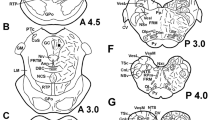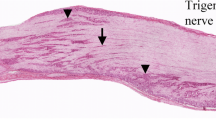Abstract
Immunoreacttvtty to various peptides has been demonstrated in nerve terminals around the sweat glands, suggesting a regulatory function for these peptides on sweating. The present study evaluated the calcitonin-gene related peptide and substance P related regulation of sweating in man. Both calcitonin-gene related peptide and substance P, when administered alone, failed to cause sweat secretion, whereas sweating induced by methacholine chloride alone was four times greater when administered with calcitonin-gene related peptide and suppressed by 70% when administered with substance P. The degree of calcitonin-gene related peptide dependent augmentation and substance P dependent suppression of the methacholine chloride induced sweating was dependent on the concentration of calcitonin-gene related peptide and substance P. These findings suggest that calcitonin-gene related peptide enhances cholinergic sweating and substance P inhibits it.
Similar content being viewed by others
References
Lundberg JM, Hökfelt T. Multiple co-existence of peptides and classical transmitters in peripheral autonomic and sensory neurons—functional and pharmacological implications. In: Hökfelt T, Fuxe K, Pernow B, eds.Progress in Brain Research, Vol 68. Amsterdam/New York: Elsevier, 1986, 241–262.
Lindh B, Lundberg JM, Hökfelt T. NPY-, galanin-, VIP/PHI-, CGRP- and substance P-immunoreactive neuronal subpopulations in cat autonomic and sensory ganglia and their projections.Cell Tissue Res 1989;256: 259–273.
Kruger L, Silverman JD, Mantyh PW, Sternini C, Brecha NC. Peripheral patterns of calcitonin-gene-related peptide general somatic sensory innervation: cutaneous and deep terminations.J Comp Neurol 1989;280: 291–302.
Lundberg JM, Hökfelt T, Schultzberg M, Uvnäs-Wallensten K, Köhler C, Said SI. Occurrence of vasoactive intestinal polypeptide (VIP)-like immunoreactivity in certain cholinergic neurons of the cat: evidence from combined immunohistochemistry and acetylcholinesterase staining.Neuroscience 1979:4: 1539–1559.
Gibbins IL, Wattchow D, Coventry B. Two immunohistochemically identified populations of calcitonin gene-related peptide (CGRP)-immunoreactive axons in human skin.Brain Res 1987;414: 143–148.
Tainio H, Vaalasti A, Rechardt L. The distribution of substance P-, CGRP-, galanin- and ANP-like immunoreactive nerves in human sweat glands.Histochem J 1987;19: 375–380.
Lindh B, Haegerstrand A, Lundberg JM,et al. Substance P-, VIP- and CGRP-like immunoreactivities coexist in a population of cholinergic postganglionic sympathetic nerves innervating sweat glands in the cat.Acta Physiol Scand 1988;134: 569–570.
Lindh B, Pelto-Huikko M. Haegerstrand A, Schalling M, Lundberg JM, Hökfelt T. Substance P is present in cholinergic paravertebral sympathetic neurons innervating exocrine sweat glands. In: Leeman SE, Krause JE, Lembeck F, eds.Annals of the New York Academy of Science, Vol 632. New York: New York Academy of Sciences, 1991: 423–430.
Yamashita Y, Ogawa T, Ohnishi N, Imamura R, Sugenoya J. Local effect of vasoactive intestinal polypeptide on human sweatgland function.Jpn J Physiol 1987;37: 929–936.
Yamashita Y, Ogawa T, Sugenoya J, Ohnishi N, Natsume K, Imamura R. Effects of atrial natriuretic peptide on human sweating activity.Auton Nerv Sys 1989;26: 523–530.
Sugenoya J, Ogawa T. Characteristics of central sudomotor mechanism estimated by frequency of sweat expulsions.Jpn J Physiol 1985;35: 783–794.
Kumazawa K, Sobue G, Mitzuma T, Ogawa T, Sugenoya J. Effect of aging on postganglionic sudomotor function in man. In: Yoshikawa M,et al., eds.New Trends in Autonomic Nervous System Research. Amsterdam: Elsevier, 1991: 94–95.
Brain SD, Williams TJ, Tippins JR, Morris HR, Maclntyre I. Calcitonin gene-related peptide is a potent vasodilator.Nature 1985;313: 54–56.
Pernow B. Substance P.Pharmacol Rev 1983;35: 85–141.
Brain SD, Williams TJ. Substance P regulates the vasodilator activity of calcitonin gene-related peptide.Nature 1988;335: 73–75.
Sato K, Sato F. Effect of VIP on sweat secretion and cAMP accumulation in isolated simian eccrine glands.Am J Physiol 1987;253: R935-R941.
Jänlg W. Functions of sympathetic innervation of the skin. In: Loewy AD, Spyer KM, eds.Central Regulation of Autonomic Functions. New York/Oxford: Oxford University Press, 1990: 334–348.
Kruger L. Morphological features of thin sensory afferen fibers: a new interpretation of ‘nociceptor’ function. In: Hamanp W, Iggo A, eds.Progress in Brain Research, Vol 74. Amsterdam/New York: Elsevier, 1988: 253–257.
Maggi CA, Meli A. The sensory-efferent function of capsaicin-sensitive sensory neurons.Gen Pharmac 1988;19: 1–43.
Author information
Authors and Affiliations
Rights and permissions
About this article
Cite this article
Kumazawa, K., Sobue, G., Mitsuma, T. et al. Modulatory effects of calcitonin gene-related peptide and substance P on human cholinergic sweat secretion. Clinical Autonomic Research 4, 319–322 (1994). https://doi.org/10.1007/BF01821532
Received:
Revised:
Accepted:
Issue Date:
DOI: https://doi.org/10.1007/BF01821532




